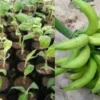- このトピックは空です。
- 投稿者投稿
- 3月 20, 2025 9:43 am #598205

Within the vibrant tapestry of Nigerian cuisine, the humble cocoyam holds a place of significant cultural and nutritional importance.
Cocoyam Consumption In Nigeria is deeply rooted in tradition, reflecting the tuber’s versatility and its role in sustaining communities across the nation. From hearty stews to delicate fritters, cocoyam’s presence is a testament to its enduring appeal.
1. Regional Variations in Culinary Use
Cocoyam’s culinary applications vary significantly across Nigeria’s diverse regions. In the eastern states, it’s often boiled or pounded into “ekpang nkukwo,” a traditional dish made with grated cocoyam and vegetables.
In the south, it’s used to thicken soups and stews, lending a creamy texture and earthy flavor. In the north, it’s sometimes dried and ground into flour for use in various dishes. These regional variations highlight cocoyam’s adaptability and its integration into local food cultures.
2. Nutritional Significance and Health Benefits
Cocoyam is a valuable source of carbohydrates, dietary fiber, and essential vitamins and minerals. It’s particularly rich in potassium, which is important for maintaining healthy blood pressure. The high fiber content aids digestion and promotes gut health. Cocoyam is also a good source of antioxidants, which can help protect against oxidative stress. Its nutritional profile makes it a staple in many Nigerian diets, contributing to overall health and well-being.
3. Role in Traditional Festivals and Ceremonies
Cocoyam plays a significant role in traditional festivals and ceremonies across Nigeria. It’s often prepared and served during cultural celebrations, religious events, and social gatherings.
Its presence symbolizes abundance and prosperity, reinforcing its cultural importance. Traditional dishes made with cocoyam are often passed down through generations, preserving cultural heritage.
4. Impact on Local Economies and Agriculture
Cocoyam cultivation supports the livelihoods of many smallholder farmers in Nigeria. It’s a relatively low-input crop, making it accessible to farmers with limited resources.
The demand for cocoyam creates market opportunities for farmers and traders, contributing to local economies. Its cultivation also contributes to agricultural diversity, enhancing food security.
5. Challenges and Opportunities in Modern Consumption
While cocoyam remains a staple, modern consumption patterns are evolving. Urbanization and changing lifestyles have led to a shift towards convenience foods, potentially impacting cocoyam consumption.
However, there’s a growing interest in traditional foods and healthy eating, creating opportunities for cocoyam to regain popularity.
Promoting cocoyam’s nutritional benefits and culinary versatility can help ensure its continued consumption in Nigeria.
Cocoyam Consumption In Nigeria is a reflection of the tuber’s deep-rooted cultural and nutritional significance. Its adaptability and versatility have made it a staple in Nigerian diets, contributing to food security and cultural heritage.
As consumption patterns evolve, promoting cocoyam’s benefits can ensure its continued role in Nigerian cuisine.
- 投稿者投稿
- このトピックに返信するにはログインが必要です。






